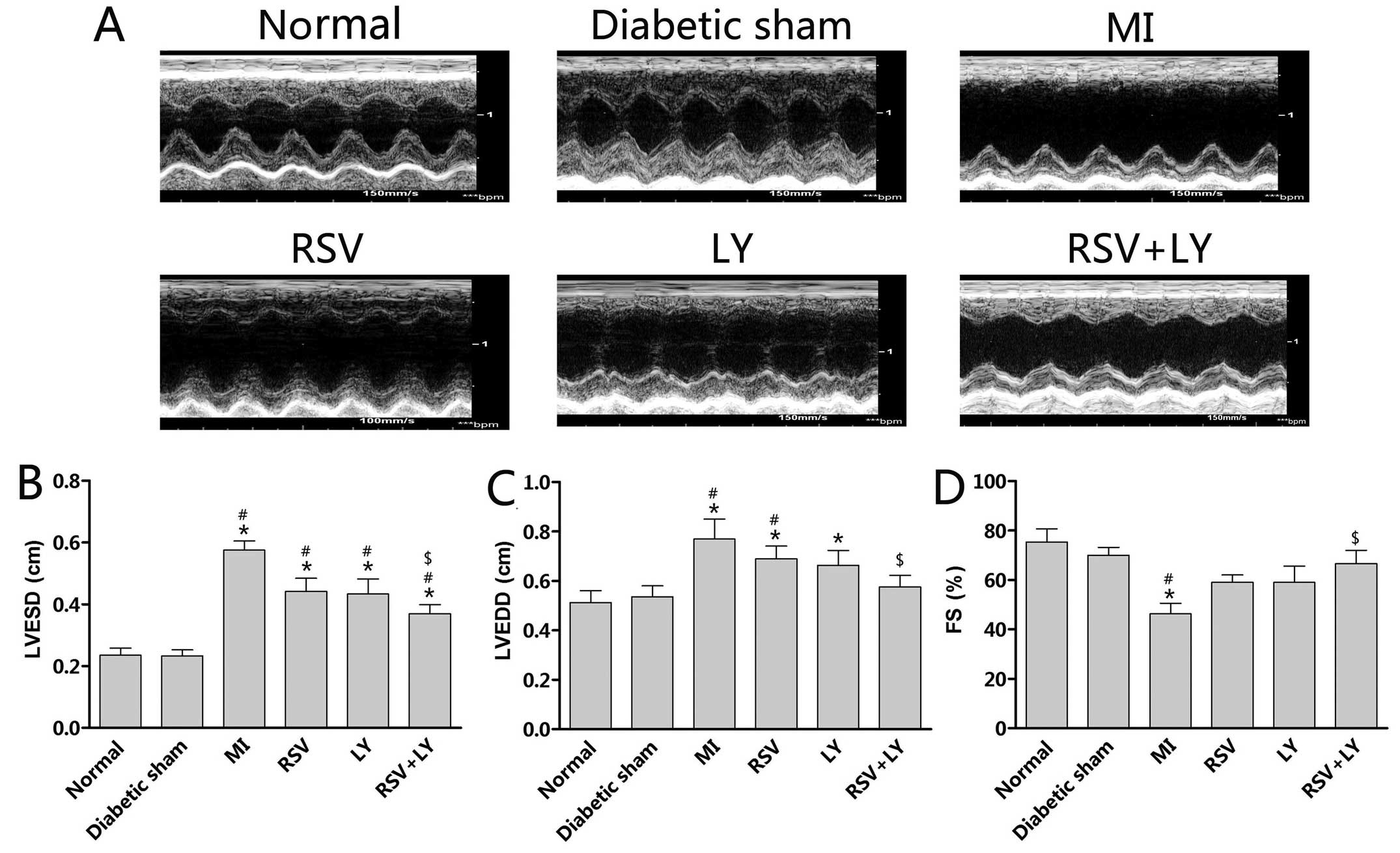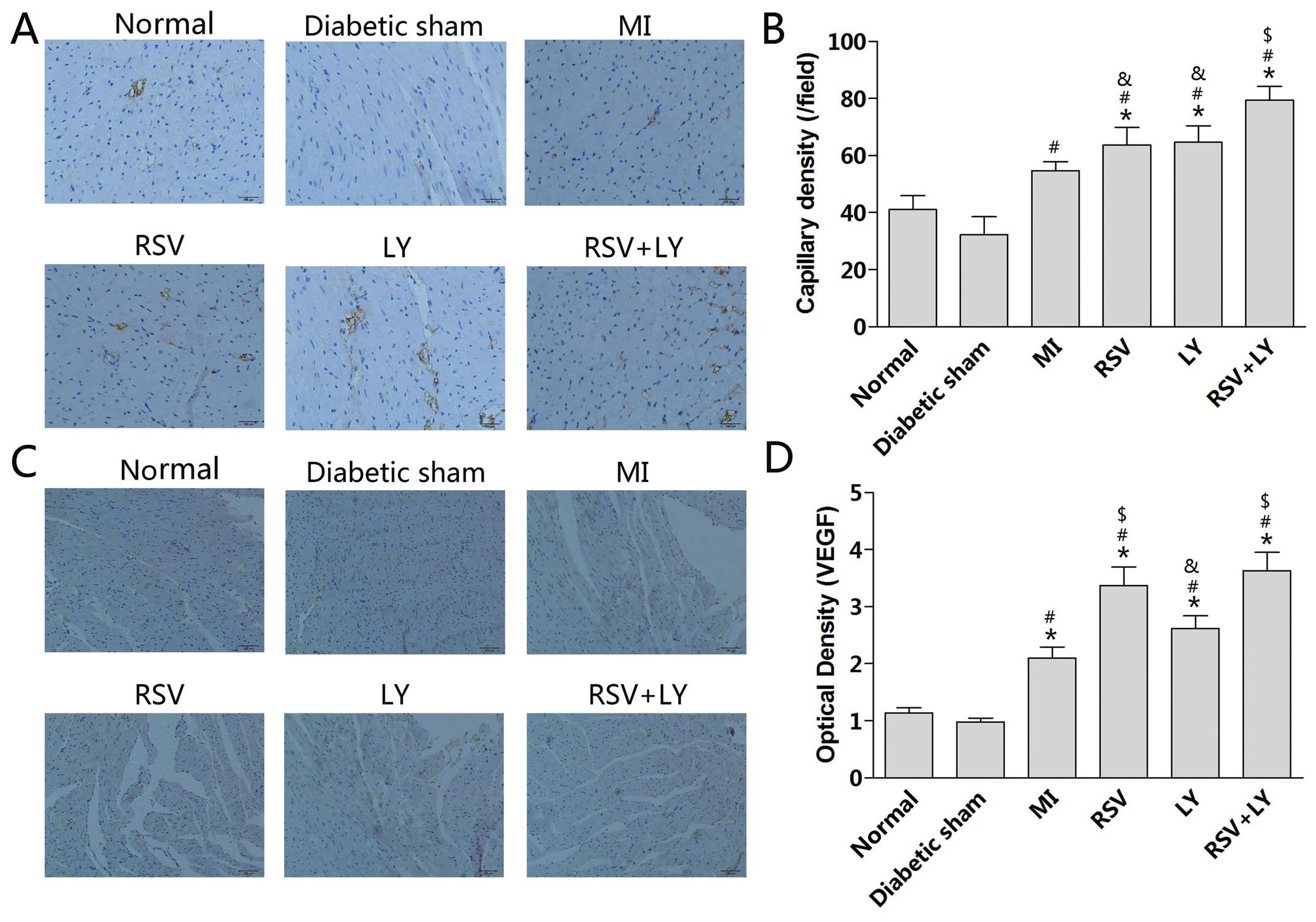|
1
|
Nordlie MA, Wold LE and Kloner RA: Genetic
contributors toward increased risk for ischemic heart disease. J
Mol Cell Cardiol. 39:667–679. 2005. View Article : Google Scholar : PubMed/NCBI
|
|
2
|
Habib GB, Heibig J, Forman SA, Brown BG,
Roberts R, Terrin ML, et al: Influence of coronary collateral
vessels on myocardial infarct size in humans: results of phase I
Thrombolysis in Myocardial Infarction (TIMI) trial: the TIMI
Investigators. Circulation. 83:739–746. 1991. View Article : Google Scholar : PubMed/NCBI
|
|
3
|
Samuel SM, Thirunavukkarasu M, Penumathsa
SV, Koneru S, Zhan L, Maulik G, et al: Thioredoxin-1 gene therapy
enhances angiogenic signaling and reduces ventricular remodeling in
infarcted myocardium of diabetic rats. Circulation. 121:1244–1255.
2010. View Article : Google Scholar : PubMed/NCBI
|
|
4
|
Boodhwani M, Sodha NR, Mieno S, Xu SH,
Feng J, Ramlawi B, et al: Functional, cellular, and molecular
characterization of the angiogenic response to chronic myocardial
ischemia in diabetes. Circulation. 116(11 Suppl): 131–137. 2007.
View Article : Google Scholar
|
|
5
|
Martin A, Komada MR and Sane DC: Abnormal
angiogenesis in diabetes mellitus. Med Res Rev. 23:117–145. 2003.
View Article : Google Scholar
|
|
6
|
Shweiki D, Itin A, Soffer D and Keshet E:
Vascular endothelial growth factor induced by hypoxia may mediate
hypoxia-initiated angiogenesis. Nature. 359:843–845. 1992.
View Article : Google Scholar : PubMed/NCBI
|
|
7
|
Hammes HP, Lin J, Bretzel RG, Brownlee M
and Breier G: Upregulation of the vascular endothelial growth
factor/vascular endothelial growth factor receptor system in
experimental background diabetic retinopathy of the rat. Diabetes.
47:401–406. 1998. View Article : Google Scholar : PubMed/NCBI
|
|
8
|
Cooper ME, Vranes D, Youssef S, Stacker
SA, Cox AJ, Rizkalla B, et al: Increased renal expression of
vascular endothelial growth factor (VEGF) and its receptor VEGFR-2
in experimental diabetes. Diabetes. 48:2229–2239. 1999. View Article : Google Scholar : PubMed/NCBI
|
|
9
|
Chou E, Suzuma I, Way KJ, Opland D,
Clermont AC, Naruse K, et al: Decreased cardiac expression of
vascular endothelial growth factor and its receptors in
insulin-resistant and diabetic States: a possible explanation for
impaired collateral formation in cardiac tissue. Circulation.
105:373–379. 2002. View Article : Google Scholar : PubMed/NCBI
|
|
10
|
Mellor H and Parker PJ: The extended
protein kinase C super-family. Biochem J. 332:281–292. 1998.
|
|
11
|
Geraldes P and King GL: Activation of
protein kinase C isoforms and its impact on diabetic complications.
Circ Res. 106:1319–1331. 2010. View Article : Google Scholar : PubMed/NCBI
|
|
12
|
Inoguchi T, Battan R, Handler E, Sportsman
JR, Heath W and King GL: Preferential elevation of protein kinase C
isoform II and diacylglycerol levels in the aorta and heart of
diabetic rats: differential reversibility to glycemic control by
islet cell transplantation. Proc Natl Acad Sci USA. 89:11059–11063.
1992. View Article : Google Scholar
|
|
13
|
Sheetz MJ and King GL: Molecular
understanding of hyperglycemia’s adverse effects for diabetic
complications. JAMA. 288:2579–2588. 2002. View Article : Google Scholar : PubMed/NCBI
|
|
14
|
Wei L, Yin Z, Yuan Y, Hwang A, Lee A, Sun
D, et al: A PKC-beta inhibitor treatment reverses cardiac
microvascular barrier dysfunction in diabetic rats. Microvasc Res.
80:158–165. 2010. View Article : Google Scholar : PubMed/NCBI
|
|
15
|
Naruse K, Rask-Madsen C, Takahara N, Ha
SW, Suzuma K, Way KJ, et al: Activation of vascular protein kinase
C-beta inhibits Akt-dependent endothelial nitric oxide synthase
function in obesity-associated insulin resistance. Diabetes.
55:691–698. 2006. View Article : Google Scholar : PubMed/NCBI
|
|
16
|
He Z and King GL: Protein kinase C beta
isoform inhibitors: a new treatment for diabetic cardiovascular
diseases. Circulation. 110:7–9. 2004. View Article : Google Scholar : PubMed/NCBI
|
|
17
|
Sata M, Nishimatsu H, Osuga J, Tanaka K,
Ishizaka N, Ishibashi S, et al: Statins augment collateral growth
in response to ischemia but they do not promote cancer and
atherosclerosis. Hypertension. 43:1214–1220. 2004. View Article : Google Scholar : PubMed/NCBI
|
|
18
|
Erbs S, Beck EB, Linke A, Adams V, Gielen
S, Kränkel N, et al: High-dose rosuvastatin in chronic heart
failure promotes vasculogenesis, corrects endothelial function, and
improves cardiac remodeling–results from a randomized,
double-blind, and placebo-controlled study. Int J Cardiol.
146:56–63. 2011. View Article : Google Scholar
|
|
19
|
Siddiqui AJ, Gustafsson T, Fischer H,
Widegren U, Hao X, Mansson-Broberg A, et al: Simvastatin enhances
myocardial angiogenesis induced by vascular endothelial growth
factor gene transfer. J Mol Cell Cardiol. 37:1235–1244.
2004.PubMed/NCBI
|
|
20
|
Miura S, Matsuo Y and Saku K:
Transactivation of KDR/Flk-1 by the B2 receptor induces tube
formation in human coronary endothelial cells. Hypertension.
41:1118–1123. 2003. View Article : Google Scholar : PubMed/NCBI
|
|
21
|
Nakamura S, Chikaraishi Y, Tsuruma K,
Shimazawa M, Hara H, et al: Ruboxistaurin, a PKCbeta inhibitor,
inhibits retinal neovascularization via suppression of
phosphorylation of ERK1/2 and Akt. Exp Eye Res. 90:137–145. 2010.
View Article : Google Scholar
|
|
22
|
Shi F, Wang YC, Zhao TZ, Zhang S, Du TY,
Yang CB, et al: Effects of simulated microgravity on human
umbilical vein endothelial cell angiogenesis and role of the
PI3K-Akt-eNOS signal pathway. PLoS One. 7:e403652012. View Article : Google Scholar : PubMed/NCBI
|
|
23
|
Huang FY, Mei WL, Li YN, Tan GH, Dai HF,
Guo JL, et al: Toxicarioside A inhibits tumor growth and
angiogenesis: involvement of TGF-β/endoglin signaling. PLoS One.
7:e503512012. View Article : Google Scholar
|
|
24
|
Xin P, Zhu W, Li J, Ma S, Wang L, Liu M,
et al: Combined local ischemic postconditioning and remote
perconditioning recapitulate cardioprotective effects of local
ischemic preconditioning. Am J Physiol Heart Circ Physiol.
298:H1819–H1831. 2010. View Article : Google Scholar : PubMed/NCBI
|
|
25
|
Derumeaux G, Mulder P, Richard V,
Chagraoui A, Nafeh C, Bauer F, et al: Tissue Doppler imaging
differentiates physiological from pathological pressure-overload
left ventricular hypertrophy in rats. Circulation. 105:1602–1608.
2002. View Article : Google Scholar : PubMed/NCBI
|
|
26
|
Tang JM, Wang JN, Zhang L, Zheng F, Yang
JY, Kong X, et al: VEGF/SDF-1 promotes cardiac stem cell
mobilization and myocardial repair in the infarcted heart.
Cardiovasc Res. 91:402–411. 2011. View Article : Google Scholar : PubMed/NCBI
|
|
27
|
Xie J, Lu W, Gu R, Dai Q, Zong B, Ling L,
et al: The impairment of ILK related angiogenesis involved in
cardiac maladaptation after infarction. PLoS One. 6:e241152011.
View Article : Google Scholar : PubMed/NCBI
|
|
28
|
Yu T, Zhu W, Gu B, Li S, Wang F, Liu M, et
al: Simvastatin attenuates sympathetic hyperinnervation to prevent
atrialfibrillation during the postmyocardial infarction remodeling
process. J Appl Physiol. 113:1937–1944. 2012. View Article : Google Scholar
|
|
29
|
Chilian WM, Penn MS, Pung YF, Dong F,
Mayorga M, Ohanyan V, et al: Coronary collateral growth - back to
the future. J Mol Cell Cardiol. 52:905–911. 2012. View Article : Google Scholar : PubMed/NCBI
|
|
30
|
Hoole SP, White PA, Read PA, Heck PM, West
NE, O’Sullivan M, et al: Coronary collaterals provide a constant
scaffold effect on the left ventricle and limit ischemic left
ventricular dysfunction in humans. J Appl Physiol. 112:1403–1409.
2012. View Article : Google Scholar : PubMed/NCBI
|
|
31
|
Fujita M, Ikemoto M, Kishishita M, Otani
H, Nohara R, Tanaka T, et al: Elevated basic fibroblast growth
factor in pericardial fluid of patients with unstable angina.
Circulation. 94:610–613. 1996. View Article : Google Scholar : PubMed/NCBI
|
|
32
|
Chilian WM, Mass HJ, Williams SE, Layne
SM, Smith EE, Scheel KW, et al: Microvascular occlusions promote
coronary collateral growth. Am J Physiol. 258:H1103–H1111.
1990.PubMed/NCBI
|
|
33
|
Abaci A, Oguzhan A, Kahraman S, Eryol NK,
Unal S, Arinc H, et al: Effect of diabetes mellitus on formation of
coronary collateral vessels. Circulation. 99:2239–2242. 1999.
View Article : Google Scholar : PubMed/NCBI
|
|
34
|
Yarom R, Zirkin H, Stammler G and Rose AG:
Human coronary microvessels in diabetes and ischaemia. Morphometric
study of autopsy material. J Pathol. 166:265–270. 1992. View Article : Google Scholar : PubMed/NCBI
|
|
35
|
Dubois S, Madec AM, Mesnier A, Armanet M,
Chikh K, Berney T, et al: Glucose inhibits angiogenesis of isolated
human pancreatic islets. J Mol Endocrinol. 45:99–105. 2010.
View Article : Google Scholar : PubMed/NCBI
|
|
36
|
Elewa HF, El-Remessy AB, Somanath PR and
Fagan SC: Diverse effects of statins on angiogenesis: new
therapeutic avenues. Pharmacotherapy. 30:169–176. 2010. View Article : Google Scholar : PubMed/NCBI
|
|
37
|
Zaitone SA and Abo-Gresha NM: Rosuvastatin
promotes angiogenesis and reverses isoproterenol-induced acute
myocardial infarction in rats: role of iNOS and VEGF. Eur J
Pharmacol. 691:134–142. 2012. View Article : Google Scholar : PubMed/NCBI
|
|
38
|
Liu Y, Lei S, Gao X, Mao X, Wang T, Wong
GT, et al: PKCβ inhibition with ruboxistaurin reduces oxidative
stress and attenuates left ventricular hypertrophy and dysfunction
in rats with streptozotocin-induced diabetes. Clin Sci (Lond).
122:161–173. 2012. View Article : Google Scholar
|
|
39
|
Kelly DJ, Zhang Y, Hepper C, Gow RM,
Jaworski K, Kemp BE, et al: Protein kinase C beta inhibition
attenuates the progression of experimental diabetic nephropathy in
the presence of continued hypertension. Diabetes. 52:512–518. 2003.
View Article : Google Scholar : PubMed/NCBI
|
|
40
|
Wang F, Huang D, Zhu W, Li S, Yan M, Wei
M, et al: Selective inhibition of PKCβ2 preserves cardiac function
after myocardial infarction and is associated with improved
angiogenesis of ischemic myocardium in diabetic rats. Int J Mol
Med. 32:1037–1046. 2013.PubMed/NCBI
|
|
41
|
Ikeda A, Matsushita S and Sakakibara Y:
Inhibition of protein kinase Cβ ameliorates impaired angiogenesis
in type I diabetic mice complicating myocardial infarction. Circ J.
76:943–949. 2012. View Article : Google Scholar
|
|
42
|
Ma YX, Li WH and Xie Q: Rosuvastatin
inhibits TGF-beta1 expression and alleviates myocardial fibrosis in
diabetic rats. Pharmazie. 68:355–358. 2013.PubMed/NCBI
|
|
43
|
Palaniyandi SS, Ferreira JC, Brum PC and
Mochly-Rosen D: PKCβII inhibition attenuates myocardial infarction
induced heart failure and is associated with a reduction of
fibrosis and pro-inflammatory responses. J Cell Mol Med.
15:1769–1777. 2011. View Article : Google Scholar :
|















